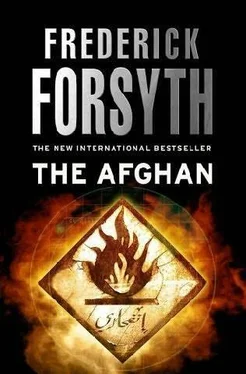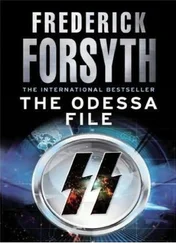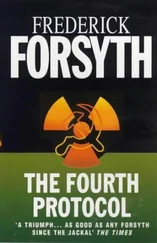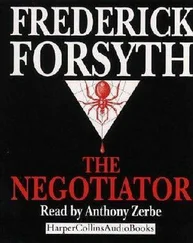The face had been one of the “first division” in the gallery he had been shown at Castle Forbes. The man was short and stocky, as expected, and the stunted left arm hung by his side. He had fought in Afghanistan against the Soviets, and his left arm had stopped several shards of shrapnel during an air attack. Rather than accept a clean amputation, he preferred to let it hang, useless. There had been rumors that he had died there. Not true. He had been patched up in the caves, then smuggled into Pakistan for more advanced surgery. After the Soviet evacuation, he had disappeared.
The man with the withered left arm reappeared after the 2003 coalition invasion of Iraq, having spent the missing time as chief of security in one of the AO^camps under Taliban rule.
For Mike Martin, there was a heart-stopping moment in case the man recognized Izmat Khan from those Afghan days and wished to discuss it. But the mission commander just stared at him with featureless black-pebble eyes. For twenty years, this man had killed and killed, and he loved it. In Iraq, as aide to Musab al-Zarqawi, he had hacked off heads on camera and loved it. He loved to hear them plead and scream. Martin gazed into the blank, manic eyes and gave the habitual greeting. Peace be unto you, Yusef Ibrahim, Butcher of Karbala.
The former Java Star emerged from the hidden Filipino creek twelve hours after the destruction of the Countess of Richmond. She cleared the Moro Gulf, and headed into the Celebes Sea, heading south by southwest, to join the sea track the Countess would have taken though the Makassar Strait. The Indonesian helmsman had the wheel, but beside him stood the British/Pakistani teenager and the Afghan, to whom he gave instruction on the keeping of a true course at sea.
Though neither of his pupils could be aware of it, counterterror-ist agencies within the world of the merchant marine had known for years, and been perplexed by the times a ship in these waters had been hijacked, steered round in circles for several hours with her crew in the chain locker, then abandoned. The reason was simply that just as the hijackers of 9/11 had achieved their practice in U.S. flying schools, the marine hijackers of the Far East have been practicing the handling of a large ship at sea. The Indonesian at the helm of the new Countess was one of these.
The engineer down below really had been a marine engineer before the ship he worked on had been hijacked by Abu Sayyaf. Rather than die, he had agreed to join the terrorists and become one of them.
The third Indonesian had learned all about ship-to-shore radio procedures while working in the harbormaster’s office of a North Borneo trading port until he was radicalized in Islam and accepted into the ranks of Jemaat Islamiyah, later helping to plant the Bali disco bombs.
These were the only three of eight who needed technical knowledge of ships. The Arab chemist would eventually be in charge of cargo detonation; the man from the UAE Suleiman would take the data stream images that would rock the world; the Pakistani youth would, if need be, emulate the North Country voice of Captain McKendrick; and the Afghan would “spell” the helmsman at the wheel through the days of cruising that lay ahead.
***
By the end of March, spring had not even attempted to touch the Cascade range. It was still bitterly cold, and snow lay thick in the forest beyond the walls of the Cabin.
Inside, it was snug and warm. The enemy, despite TV day and night, movies on DVD, music and board games, was boredom. As with lighthouse keepers, the men had not much to do, and the six-month term was a great test of the capacity of internal solitude and self-sufficiency.
Nevertheless, the guard detail could don skis or snowshoes and slog through the forest to keep fit and to get a break from the bunk-house, eatery and game room. For the prisoner, immune to fraternization, the strain was that much greater. Izmat Khan had listened to the president of the military court at Guantanamo pronounce him free to go, and was convinced Pul-i-Charki jail would not have held him for more than a year. When he was brought to this lonely wilderness-so far as he knew, forever-it was hard to hide the screaming rage inside. So he donned the kapok-lined jacket they had issued him, let himself outside and paced up and down the walled enclosure. Ten paces long, five paces wide. He could do it with eyes shut and never bump into the concrete. The only variety was occasionally in the sky above.
Mostly, it was of heavy, leaden gray cloud, from which the snow drifted down. But earlier, in that period when the Christians decorated trees and sang songs, the skies had been freezing cold but blue.
Then he had seen eagles and ravens wheeling overhead. Smaller birds had fluttered to the top of the wall and looked down at him, perhaps wondering why he could not come and join them in freedom. But what he liked most to watch were the airplanes.
Some he knew were warplanes, though he had heard of neither the Cascade range, where he was, nor McChord Air Force Base, fifty miles to the west. But he had seen American combat aircraft turning into their bombing runs over northern Afghanistan and he knew these were the same.
And there were the airliners. They were in different liveries, with varying designs on their tails, but he knew enough to know these were not national but company insignias. Except for the maple leaf. Some always had that leaf on the tail; they were always climbing, and they always came from the north. North was easy to work out; to the west, he could see the sun set, and he prayed the opposite way, toward Mecca, far to the east. He suspected he was in the USA because the voices of his guards were clearly American. So why did airliners with different national in-signias come from the north? It could only be because there was another land up there somewhere, a land where people prayed to a red leaf on a white ground. So he paced up and down, up and down, and wondered about the land of the red leaf. In fact, he was watching the Air Canada flights out of Vancouver.
***
In a sleazy dockside bar in Port of Spain, Trinidad, two merchant seamen were attacked by a local gang and left dead. Both had been skillfully knifed. By the time the Trinidadian police arrived, the witnesses had acquired amnesia, and could recall only that there had been five attackers who had provoked the bar fight and that they were islanders. The police would never get further than that, and no arrests were ever made.
In fact, the killers were local lowlife, and they had nothing to do with Islamist terrorism. But the man who had paid them was a senior terrorist in the Jamaat al-Muslimeen, the principal Trinidadian group on the side of Al Qaeda. Though still low profile across the Western media, JaM has been growing steadily for years, as have other groups right across the Caribbean basin. In an area known for its down-home Christian worship, Islam has been quietly growing with wholesale immigration from the Middle East, Central Asia and the Indian Subcontinent.
The money paid out by JaM for the killings came from a line of credit set up by the late Mr. Tewflk al-Qur, and the specific orders had come from an emissary of Dr. al-Khattab, who was still on the island.
No attempt had been made to steal the wallets of the dead men, so the Port of Spain police could quickly identify them as Venezuelan citizens and deck crew from a Venezuelan ship then in port.
Her master, Captain Pablo Montalban, was shocked and saddened to be informed of the loss of his crewmen, but he could not wait for too long in harbor. The details of shipping the bodies back to Caracas fell to the Venezuelan Embassy while Captain Montalban contacted his local agent for replacement sailors. The man asked around and got lucky. He came up with two polite and eager young Indians from Kerala who had worked their passage across the world, and who, even if they lacked naturalization papers, had perfectly good seamen’s tickets.
Читать дальше










